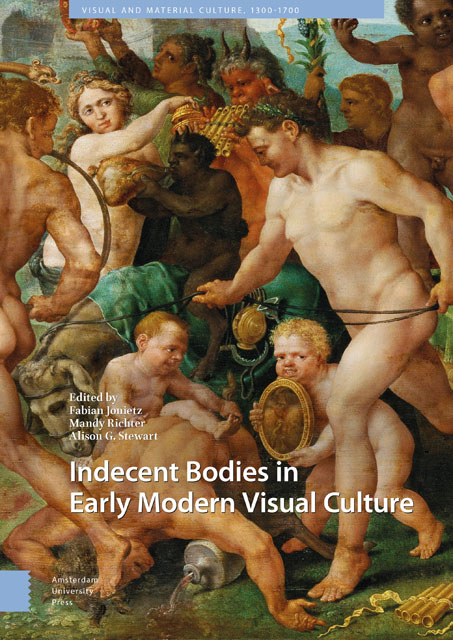Book contents
- Frontmatter
- Table of Contents
- List of Illustrations
- Indecent Bodies in Early Modern Visual Culture: An Introduction
- 1 Taste, Lust, and the Male Body: Sexual Representations in Early Sixteenth-Century Northern Europe
- 2 Private Viewings: The Frankfurt Context of Sebald Beham’s Die Nacht
- 3 To Show or Not to Show? Marcantonio Raimondi and the Representation of Female Pubic Hair
- 4 Treating Bodily Impurities: Skin, Art, and Medicine
- 5 Indecent Exposure and Honourable Uncovering in Renaissance Portraits of Women
- 6 Lust in Translation: Agency, Sexuality, and Gender Configuration in Pauwels Franck’s Allegories of Love
- 7 ‘So this guy walks into a forest…:’ obscenity, humour, sex, and the equine body in hans baldung’s Horses in a forest woodcuts (1534)
- 8 Indecent Creativity and the Tropes of Human Excreta
- 9 ‘It All Turns to Shit’ – The Land of Cockaigne in Sixteenth-Century German Woodcuts
- 10 Noëls and Bodily Fluids: The Business of Low-Country Ceremonial Fountains
- Index
6 - Lust in Translation: Agency, Sexuality, and Gender Configuration inPauwels Franck’s Allegories of Love
Published online by Cambridge University Press: 19 April 2023
- Frontmatter
- Table of Contents
- List of Illustrations
- Indecent Bodies in Early Modern Visual Culture: An Introduction
- 1 Taste, Lust, and the Male Body: Sexual Representations in Early Sixteenth-Century Northern Europe
- 2 Private Viewings: The Frankfurt Context of Sebald Beham’s Die Nacht
- 3 To Show or Not to Show? Marcantonio Raimondi and the Representation of Female Pubic Hair
- 4 Treating Bodily Impurities: Skin, Art, and Medicine
- 5 Indecent Exposure and Honourable Uncovering in Renaissance Portraits of Women
- 6 Lust in Translation: Agency, Sexuality, and Gender Configuration in Pauwels Franck’s Allegories of Love
- 7 ‘So this guy walks into a forest…:’ obscenity, humour, sex, and the equine body in hans baldung’s Horses in a forest woodcuts (1534)
- 8 Indecent Creativity and the Tropes of Human Excreta
- 9 ‘It All Turns to Shit’ – The Land of Cockaigne in Sixteenth-Century German Woodcuts
- 10 Noëls and Bodily Fluids: The Business of Low-Country Ceremonial Fountains
- Index
Summary
Abstract
Usually referred to as Allegories of Love, the fourpaintings at the Kunsthistorisches Museum of Vienna created by PauwelsFranck (1540‒1596), aka Paolo Fiammingo, present scenes of almostchoreographic sexual encounters and love-related narratives. The visualstrategies adopted by the artist in these moralising stories, along withtheir interconnected iconographies, appear in line with the debate onsexuality and gender expectations promoted in sixteenth-century Venice,reflecting ideals conveyed by contemporary treatises on love. Powerfulin their representations, these images endorse the trope ofHonest Lust, which stresses the temporarylegitimacy of depicting potentially indecent images for morallyinstructive purposes, thus allowing the beholder to visualise –and virtually experience – forms of (mis)behaviour pertaining tothe taboo-filled domains of sexuality and social normativity.
Keywords: art and obscenity; allegories of love; genderconstruction; Northern Renaissance art; Renaissance sexuality
Formerly attributed to Agostino Carracci (1557‒1602), a series of fouroil paintings representing scenes of vivid, almost choreographic sexualencounters at the Kunsthistorisches Museum of Vienna (figs. 6.1‒6.4)– usually referred to as Allegories of Love –is now consensually assigned to Pauwels Franck, also known as PaoloFiammingo (1540‒1596). While a few significant studies have beendedicated to explore the visual metaphors depicted in this series, alongwith the scrutiny of its literary sources, little (to no) attempt (at all)has been made so far to examine the connections between these paintings andthe social context of sixteenth-century Venice, in association with ideasand ideals conveyed by contemporary treatises of love. In fact, both primaryand secondary sources consecrated to this series have consistently built uptheir discourses without investigating in detail, aside from providingformal and iconographic considerations, the most blatant feature of theseworks: their pervasive, nearly sonorous eroticism. This silence has operatedwhat could be called a ‘hermeneutic neutralisation’ of thesocial as well as ideological implications of these works on canvas.
Previous studies have dated this group of paintings around 1584‒1589.The intricate narrative of their provenance has been reconstructed by OttoKurz in a seminal article published in 1951, which represents the firstscholarly oriented study ever dedicated to the series.
- Type
- Chapter
- Information
- Indecent Bodies in Early Modern Visual Culture , pp. 155 - 174Publisher: Amsterdam University PressPrint publication year: 2022



